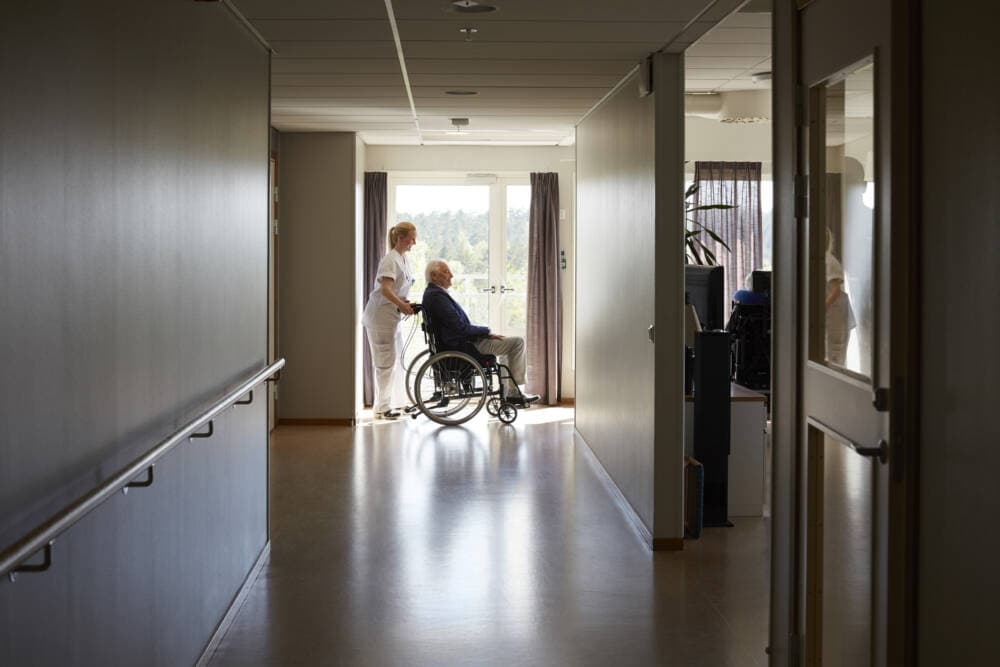Advertisement
Commentary
The neglect in nursing facilities is no accident

In 40 years of driving, I’ve had only one accident — a fender-bender. And it wasn’t even on the road, but in the parking lot beneath my mother’s apartment building. I was in the midst of driving her car to the hospital to find her a bedpan.
My mother, a healthy 83-year-old, had broken her hip. But she didn’t tell me. (I’m an author — and I was on a book tour — so, displaying her typical independence and consideration for my career, she kept the news to herself and simply arranged the replacement operation.) As soon as I heard, I flew to Florida for support and stayed in her apartment, which was some miles from the hospital where she was recovering. Around midnight, she called and woke me up. The call-button had produced no result, and she couldn’t find anyone to bring her a bedpan.
A bedpan that arrives 15 minutes late is a humiliation; half an hour late, torture; any time after that, stench and despair.
Backing her car out of a tight spot, I didn’t stop for the ghastly scraping noise as the fender raked a giant cement column. I drove to the hospital without further incident, got to her silent floor — still no one in the nurse’s station — located her room, waved quickly and stalked around the corridors like a demon, calling out until I found a person who could help.
I think of my mother’s missing bedpan with fury as we round year three of the COVID era. A lot of residents of nursing homes and rehab facilities find themselves in my mother’s situation — and far worse. Helpless and bereft, abandoned.
For them, this is an interminable and disastrous public-health crisis. Staffing remains painfully, cruelly low. Patients with mobility issues call out because they need to be repositioned to avoid bedsores. An unheeded call could be someone having a heart attack or a stroke.
People lie dehydrated and unwashed in soiled beds, leading to urinary tract infections and skin problems. Others whose needs were ignored too long may need hospitalization, or even die in their beds. One woman died outside in the cold.
Nursing facilities are a multi-billion-dollar industry that can be inefficient, cruel and lethal.
Some residents have no family to call. Some can’t or don’t complain, but the neglect is obvious. Relatives see loved ones losing weight, with unkempt hair, untrimmed nails. After the first year of COVID, a survey by the National Consumer Voice For Quality Care found that 87% of families had noticed similar deteriorations. To add insult to injury, in a report called “Broken Promises,” the Long Term Care Community Coalition, reviewing 290,000 harm reports, found many atrocious deficiencies cited by state supervisors as “not harm.”
Understaffing also destroys morale among aides. In a series of interviews captured on video by Consumer Voice, a resident named Margarite G. said that aides “go home crying” because they can’t properly care for all their clients. Forty-five people per floor, with just three aides, makes victims of both groups. Weekends can be especially miserable. “They’re tired,” resident Maurice M. kindly observed, of staff, “They’re just tired.” Some aides leave, burnt out or unable to live on the subpar pay scale. Turnover can go as high as 50% or more over a year.
Ombudsman’s complaints can’t change this. These problems are happening nationwide. They require political will on the part of states and Congress that has not been exercised for decades.
Despite what the public may think, it was not always staff illnesses or resignations that created the atrocious neglect in nursing facilities over the past three years of COVID. Nursing facilities are a multi-billion-dollar industry that can be inefficient, cruel and lethal. Some are decent employers, but in many facilities, understaffing, underpaying and overworking employees — and thus, out of necessity abusing residents — are part of the standard business model. Many for-profit owner/operators slyly siphon off the money to “related parties” they also own, like realtors or janitorial services, to give stockholders their expected dividends. Their advocates misleadingly name that despicable system “flexible” staffing.
In September 2020, Massachusetts had the worst record in the U.S.: There were 125 COVID-19 deaths per 1,000 residents in nursing homes in Massachusetts. By March 2021 at least 8,647 residents had died of COVID-related illness in the state — almost a quarter of all the residents who were alive in 2020.
This year Massachusetts’ legislators have bills in front of them to approve safe staffing ratios. Bill H623, now in front of the Joint Committee on Elder Affairs, would mandate a minimum of 4.1 hours per person per day. It could be improved; experts recommend 4.5 hours. Safe minimums attract and retain employees and give them time to provide the dignified, companionable care that residents deserve.
An amendment to Section 10 of a omnibus bill an "Act to improve quality and oversight of long-term care," would establish a living wage for direct-care staff. The pay would go directly to them, with grateful thanks — not through the pockets of the owners.
Massachusetts flunked one test of responsible caring in 2018, when Proposition 1 --which concerned safe hospital staffing ratios — was brought to voters. The lobby of the hospital association swayed voters with their menaces that hospitals would close. Now it may be the nursing-facility lobby that gets to lawmakers by threatening closures. But typically, for-profit owners can well afford higher staffing ratios. Their income is assured by Medicaid and Medicare payments, not to mention that clients on Medicaid must hand over their Social Security checks.
There’s a national movement now to better conditions in all facilities. Massachusetts reformers, including Senator Pat Jehlen and Rep. Thomas Stanley, are in the Legislature. Dignity Alliance MA — a grass-roots coalition of aging and disability service and advocacy organizations — has endorsed the omnibus bill, which if enforced would not dabble at reform but transform nursing facilities in our state.
A person turning age 65 today has almost a 70% chance of needing either rehab or long-term care, and 20% of those people will need long term care for more than five years. Clearly, the just goal is to save any of us and our loved ones from mortification, pain, misery, or death, if we too need public health care. We know how to do this. Let’s get it right this time.
Follow Cognoscenti on Facebook.
